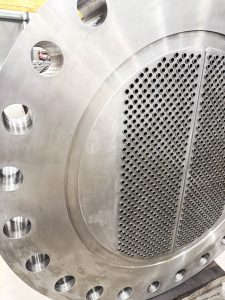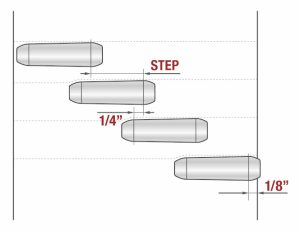Heat exchangers are critical components in nuclear, petrochemical, and energy production, often operating under high pressure and corrosive environments. These demanding conditions frequently necessitate the use of thicker tube sheets to ensure longevity and structural integrity. While thicker tube sheets offer enhanced durability, they present unique challenges during the tube expansion process. This article provides a practical guide for operators and end-users on effectively expanding tubes into thicker tube sheets.
By Erica Dzomba, Product Marketing Specialist, Elliott Tool Technologies
Understanding the challenges of thicker tube sheets
Tube sheet thickness is determined by several factors, including pressure requirements, thermal expansion considerations, corrosion allowance, and the necessary tube support. Industry standards like TEMA, API, and ASME provide specific guidelines for determining appropriate thicknesses. However, thicker tube sheets introduce complexities in the expansion process:
- Increased torque requirements: Expanding a thicker tube sheet requires long reach tooling, leading to significantly higher torque being applied. This increased torque can damage tooling through galling, pitting, or heat damage.
- Uneven expansion: The stepped expansion process used with thicker tube sheets can result in uneven expansion if not performed carefully. Missed areas can create ridges or “catch points” in the tube, which become potential failure points during operation.
- Work hardening: Overlapping expansion areas or multiple operations in the same location can lead to work hardening of the tube material. This can cause elongation and embrittlement, reducing the tube’s lifespan.
- Increased time and labor: Expanding thicker tube sheets can require 2 – 4Xs the labor compared to thinner sheets. This is due to the step rolling process, the increased number of tools needed, higher costs, and more extensive setup time for each expansion step.
The expansion process: a step-by-step guide

1. Choosing the right expander
Selecting the appropriate expander is crucial for successful tube expansion. Consider the following:
- Tube and tube sheet material compatibility: If the tube and tube sheet materials have similar yield strengths, a multi-roll tool is generally recommended. For high-yield tube materials (e.g., super duplex stainless steel), a short-roll tool is often preferred due to the lower torque applied to the tool.
- Double radius rolls: Using double radius rolls can minimize the formation of ridges during expansion, simplifying the overlap between expansion steps.
2. Step rolling technique
Step rolling is essential for achieving uniform expansion in thicker tube sheets. Follow these steps:
- Expander setup: Begin with a long-reach expander. Set the tool so that the roll ends approximately 1/8” before the back face of the tube sheet. For the next step, use another long-reach tool and set it to overlap the previous expansion by about 1/4”. Continue this process until you reach the operator side of the tube sheet.
- Sequential expansion: Expand all tubes at the deepest setting first, working from the back face to the front face. Then, use the next shorter reach expander in the series and expand all tubes again. Repeat this process, progressively shortening the expander reach. Avoid using the long-reach tool for all expansions, as this increases the load on the tool and the risk of damage.
- Tool maintenance: Maintain the tools in optimal condition. Keep them cool and clean, lubricate frequently, and remove any debris. Regularly swap out expanders to prevent overheating and premature wear.
Best practices for expanding thicker tube sheets

When expanding tubes into thicker tube sheets, it is essential to follow best practices to ensure uniform expansion, prevent damage to tooling, and maintain the structural integrity of the heat exchanger. Proper preparation, careful execution, and regular inspection can significantly improve the expansion process and extend the lifespan of both tubes and tube sheets. The following best practices can help operators achieve optimal results:
- Proper lubrication: Use a high-quality lubricant specifically designed for tube expansion to reduce friction and minimize tool wear.
- Controlled expansion: Avoid over-expanding the tubes. Follow the manufacturer’s recommendations for torque and expansion rates.
- Inspection: Thoroughly inspect each expanded tube for any defects, such as cracks, ridges, or uneven expansion.
- Training: Ensure that operators are adequately trained on the proper techniques for expanding tubes in thicker tube sheets.
Conclusion
Expanding tubes into thicker tube sheets requires careful planning, the right tools, and a thorough understanding of the challenges involved. By following the guidelines outlined in this article, operators can achieve consistent, high-quality expansions, ensuring the long-term reliability and performance of heat exchangers in demanding applications. Remember to always consult relevant industry standards (TEMA, API, ASME) for specific requirements and best practices.
About this Technical Story
This Technical Story was first published in Heat Exchanger World Magazine in June 2025. To read more Technical Stories and many other articles, subscribe to our print magazine.
Technical Stories are regularly shared with our Heat Exchanger World community. Join us and share your own Technical Story on Heat Exchanger World online and in print.

